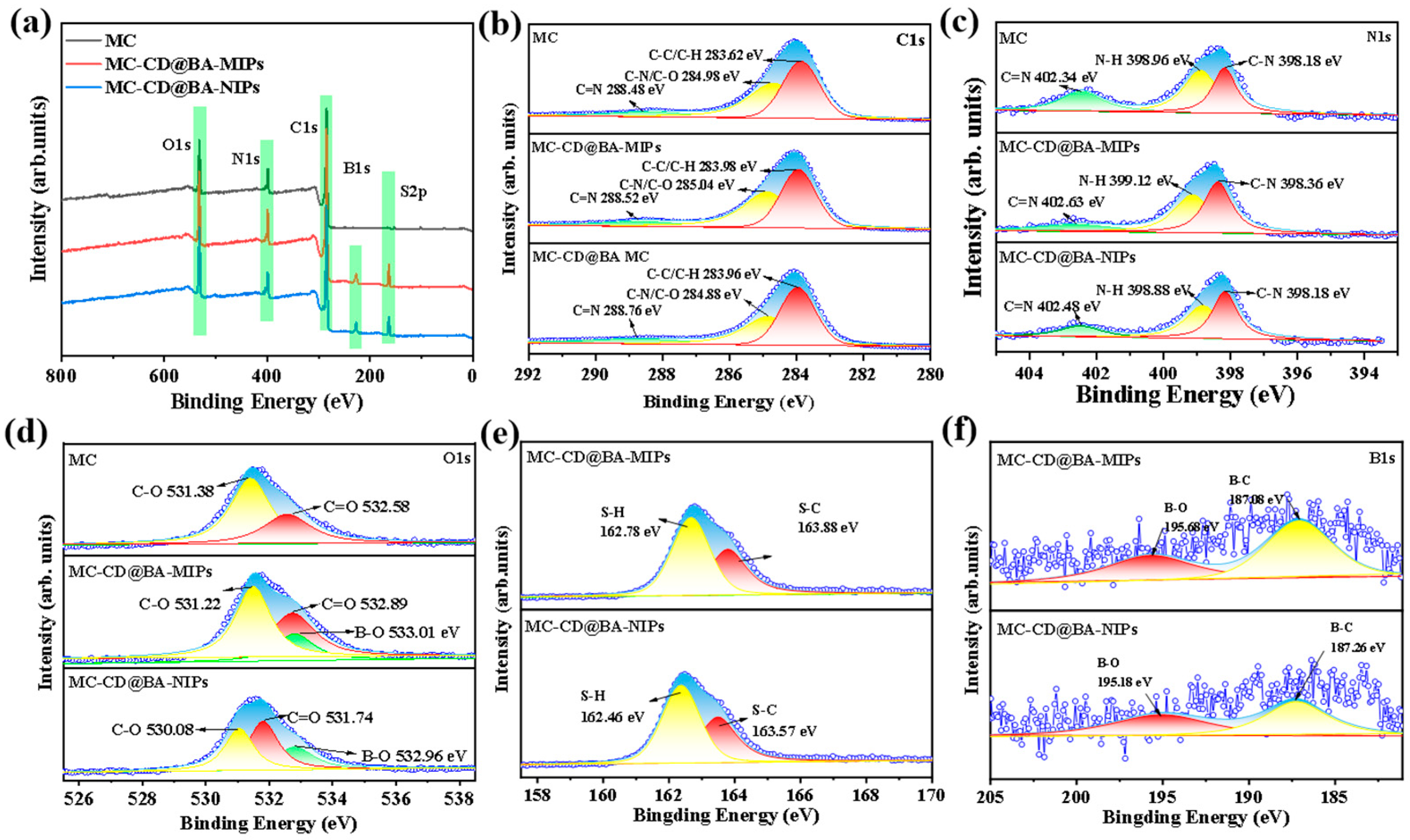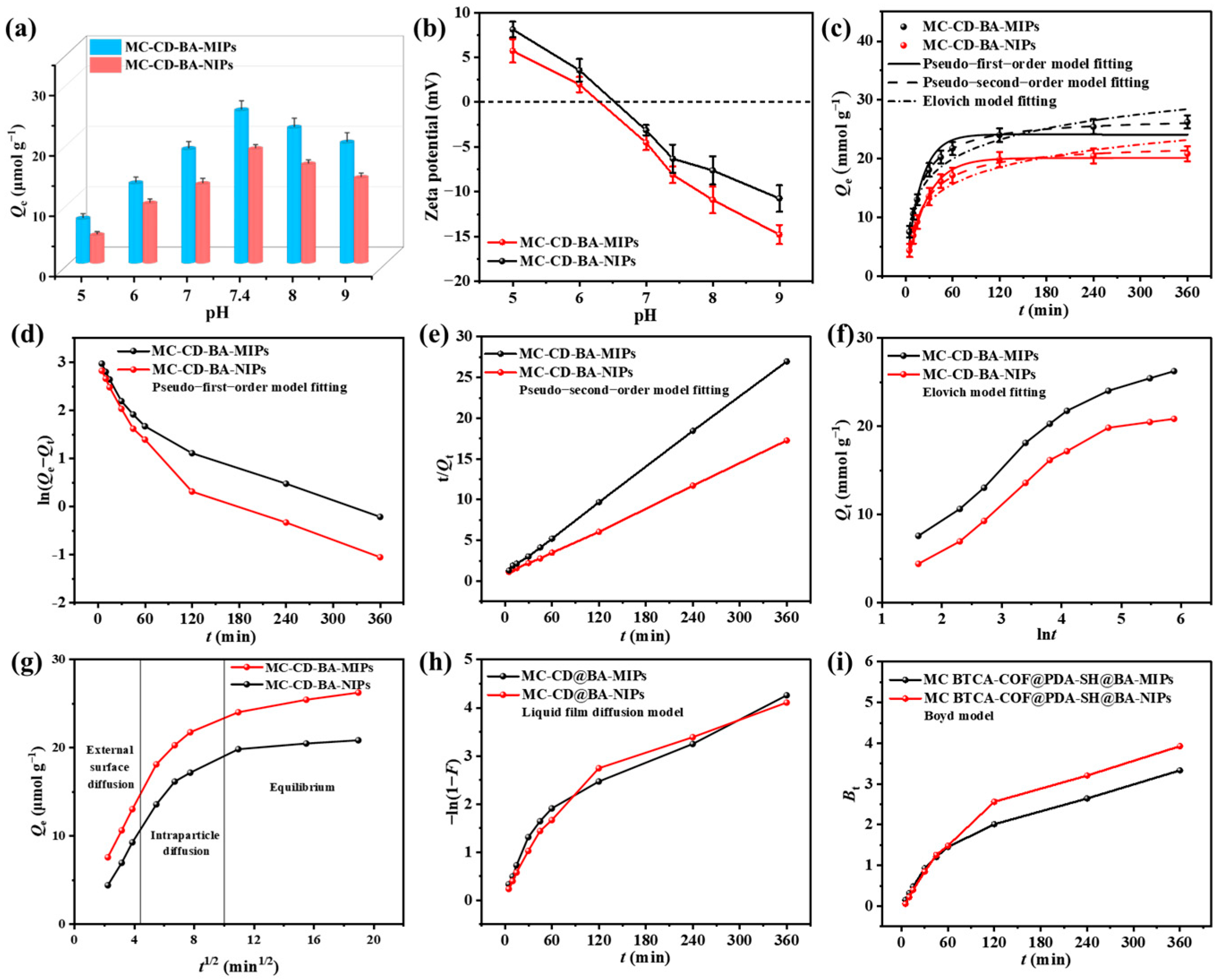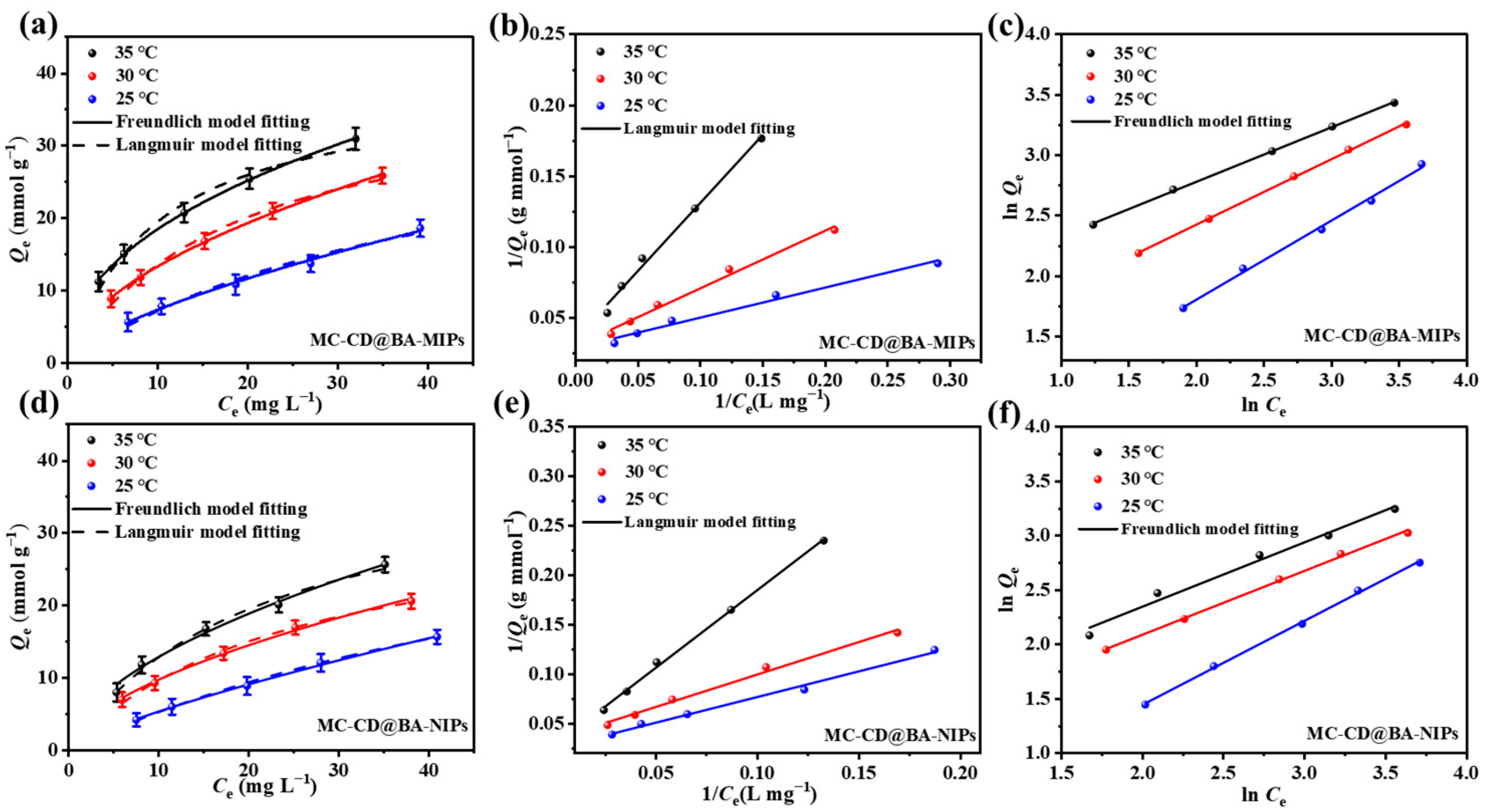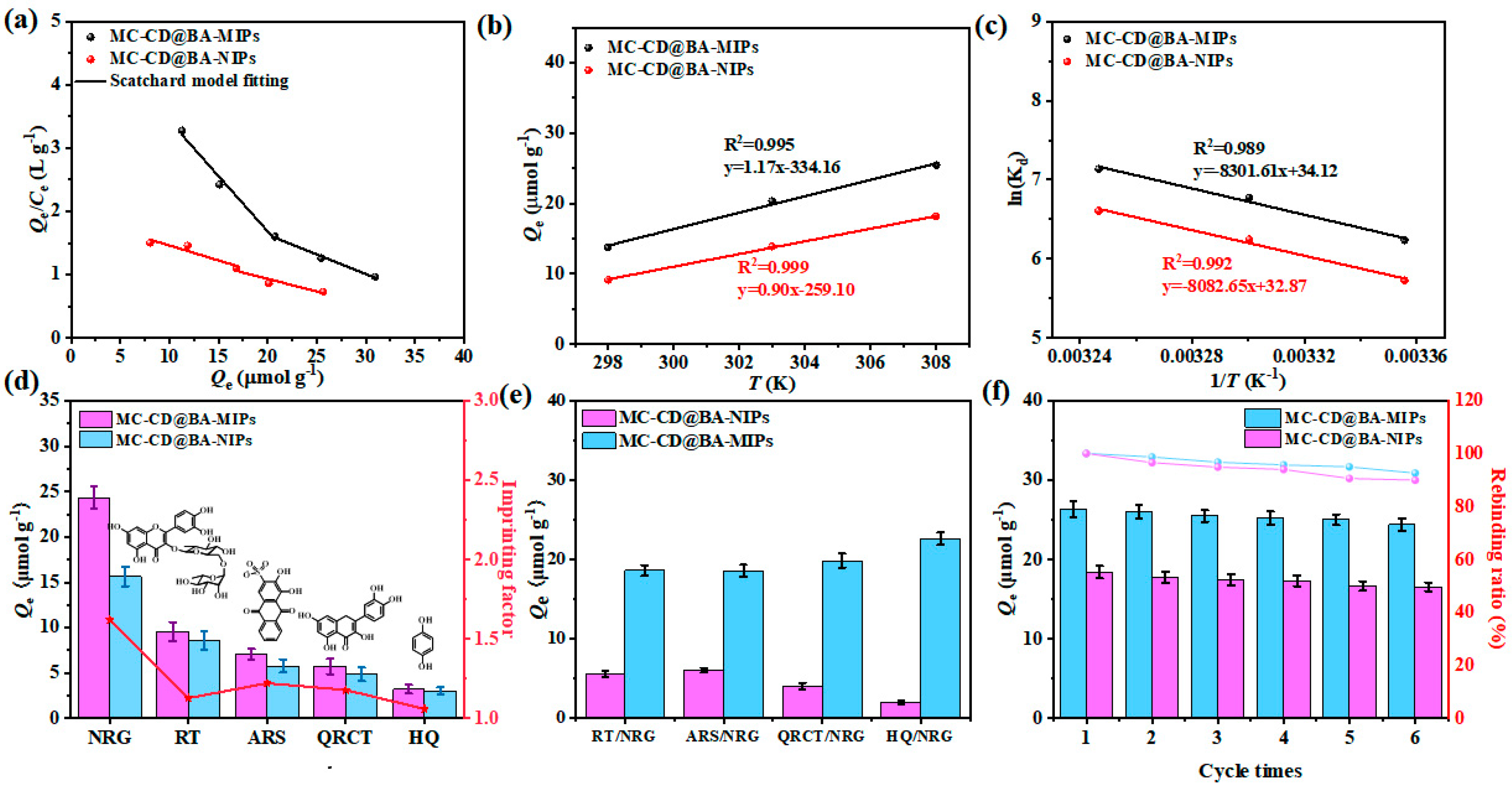Porous Imprinted Microspheres with Covalent Organic Framework-Based, Precisely Designed Sites for the Specific Adsorption of Flavonoids
Abstract
1. Introduction
2. Materials and Methods
2.1. Chemicals
2.2. Instruments and Apparatus
2.3. Preparation of Double-Bond Functionalized COF (TAPB-BTCA-DVA-COF)
2.4. Synthesis of Microsphere (MC)
2.5. Synthesis of MC-CD
2.6. Synthesis of 1-Allylpyridinium-3-Boronic Acid (APBA)
2.7. Synthesis of Boronic Acid Imprinted Microsphere (MC-CD@BA-MIP)
2.8. Binding Experiments
2.9. Selectivity Study
3. Results
3.1. Preparation of MC-CD@BA-MIPs
3.2. Characterization of MC-CD@BA-MIPs
3.3. Effect of Adsorbent Dose and pH
3.4. Adsorption Kinetics of MC-CD@BA-MIPs
3.5. Adsorption Isotherms
| Adsorption Isotherm Models | Constants | Nonlinear Form | Linear Form | ||||
|---|---|---|---|---|---|---|---|
| 25 °C | 30 °C | 35 °C | 25 °C | 30 °C | 35 °C | ||
| Langmuir model | R2 | 0.975 | 0.989 | 0.971 | 0.995 | 0.999 | 0.999 |
| Qm (µmol g−1) | 31.82 | 34.85 | 38.78 | 28.25 | 33.01 | 34.42 | |
| KL (Lμmol−1) | 0.024 | 0.054 | 0.101 | 0.002 | 0.013 | 0.013 | |
| RL | 0.45 | 0.27 | 0.17 | 0.24 | 0.52 | 0.37 | |
| Freundlich model | R2 | 0.992 | 0.998 | 0.999 | 0.995 | 0.999 | 0.999 |
| KF (μmol1−n g−1 Ln) | 1.59 | 3.91 | 6.62 | 6.53 | 3.82 | 1.64 | |
| 1/n | 0.66 | 0.63 | 0.44 | 0.45 | 0.54 | 0.65 | |
3.6. Adsorption Thermodynamics and Adsorption Mechanism
3.7. Adsorption Selectivity and Competitive
3.8. Reusability Results
4. Conclusions
Supplementary Materials
Author Contributions
Funding
Data Availability Statement
Conflicts of Interest
References
- Liu, R.R.; Wen, Z.L.; Zheng, B.; Yang, J.X.; Wang, M.; Ding, X.F.; Shi, L.J.; Hu, H.; Chen, T.Q.; Xiao, S.T.; et al. Targeted design of three-dimensional covalent organic frameworks with full exposure of functional adsorption sites for efficient iodine capture. Sep. Purif. Technol. 2025, 370, 133234. [Google Scholar] [CrossRef]
- Xiao, L.; Ye, F.Y.; Zhou, Y.; Zhao, G.H. Utilization of pomelo peels to manufacture value-added products: A review. Food Chem. 2021, 351, 129247. [Google Scholar] [CrossRef]
- Chen, R.; Qi, Q.L.; Wang, M.T.; Li, Q.Y. Therapeutic potential of naringin: An overview. Pharm. Biol. 2016, 54, 3203–3210. [Google Scholar] [CrossRef] [PubMed]
- Maaiden, E.E.; Kahia, H.E.; Nasser, B.; Moustaid, K.; Qarah, N.; Boukcim, H.; Hirich, A.; Kouisni, L.; Kharrassi, Y.E. Deep eutectic solvent-ultrasound assisted extraction as a green approach for enhanced extraction of naringenin from Searsia tripartita and retained their bioactivities. Front. Nutr. 2023, 10, 1193509. [Google Scholar] [CrossRef] [PubMed]
- Liu, Z.Z.; Qiao, L.; Gu, H.Y.; Yang, F.J.; Yang, L. Development of Brönsted acidic ionic liquid based microwave assisted method for simultaneous extraction of pectin and naringin from pomelo peels. Sep. Purif. Technol. 2017, 172, 326–337. [Google Scholar] [CrossRef]
- Yu, J.; Dandekar, D.V.; Toledo, R.T.; Singh, R.K.; Patil, B.S. Supercritical fluid extraction of limonoids and naringin from grapefruit (Citrus paradisi Macf.) seeds. Food Chem. 2007, 105, 1026–1031. [Google Scholar] [CrossRef]
- Soyekwo, F.; Liu, C.K.; Wen, H.; Raza, S. Polyamide-based membranes with nanoscale homogeneity and asymmetric structure for ultrafast ion separation. J. Membr. Sci. 2023, 685, 121921. [Google Scholar] [CrossRef]
- Li, D.J.; Chen, Y.; Liu, Z. Boronate affinity materials for separation and molecular recognition: Structure, properties and applications. Chem. Soc. Rev. 2015, 44, 8097–8123. [Google Scholar] [CrossRef]
- Qin, X.X.; Zhang, Z.; Shao, H.J.; Zhang, R.G.; Chen, L.X.; Yang, X.L. Boronate affinity material-based sensors for recognition and detection of glycoproteins. Analyst 2020, 145, 7511–7527. [Google Scholar] [CrossRef]
- Hu, Z.; Liu, S.C.; Tang, N.N.; Zhang, X.; Pan, J.M. Hierarchically porous MOFs selfsupporting copolymers for ultrafast transport and precise recognition of flavonoids: A triple interfacial crosslinking strategy based on microreactors. Sep. Purif. Technol. 2023, 326, 124819. [Google Scholar] [CrossRef]
- Yao, X.; Zhang, S.F.; Qian, L.W.; Du, M. Dendrimer-assisted boronate affinity cellulose foams for the efficient and selective separation of glycoproteins. Carbohydr. Polym. 2021, 265, 118082. [Google Scholar] [CrossRef]
- Zhang, M.Y.; Li, J.K.; Wang, R.; Zhao, S.N.; Zang, S.Q.; Mak, T. Construction of core-shell MOF@COF hybrids with controllable morphology adjustment of COF shell as a novel platform for photocatalytic cascade reactions. Adv. Sci. 2021, 8, 2101884. [Google Scholar] [CrossRef]
- Zhao, Q.Y.; Zhang, H.; Zhao, H.T.; Liu, J.; Liu, J.; Chen, Z.; Li, B.; Liao, X.J.; Regenstein, J.M.; Wang, J.; et al. Strategy of fusion covalent organic frameworks and molecularly imprinted polymers: A surprising effect in recognition and loading of cyanidin-3-O-glucoside. ACS Appl. Mater. Interfaces 2020, 12, 8751–8760. [Google Scholar] [CrossRef]
- Su, L.H.; Qian, H.L.; Yang, C.; Wang, C.X.; Wang, Z.Y.; Yan, X.P. Surface imprinted-covalent organic frameworks for efficient solid-phase extraction of fluoroquinolones in food samples. J. Hazard. Mater. 2023, 459, 132031. [Google Scholar] [CrossRef] [PubMed]
- Wang, W.; Deng, S.; Ren, L.; Li, D.; Wang, W.; Vakili, M.; Wang, B.; Huang, J.; Wang, Y.; Yu, G. Stable covalent organic frameworks as efficient adsorbents for high and selective removal of an aryl-organophosphorus flame retardant from water. ACS Appl. Mater. Interfaces 2018, 10, 30265–30272. [Google Scholar] [CrossRef] [PubMed]
- Liu, J.M.; Lv, S.W.; Yuan, X.Y.; Liu, H.L.; Wang, S. Facile construction of magnetic core-shell covalent organic frameworks as efficient solid-phase extraction adsorbents for highly sensitive determination of sulfonamide residues against complex food sample matrices. RSC Adv. 2019, 9, 14247–14253. [Google Scholar] [CrossRef] [PubMed]
- Zheng, Y.C.; Zhu, Y.C.; Xiao, F.Y.; Wang, F.S.; Wang, N. Sulfhydryl-functionalized covalent organic frameworks microspheres supported Au nanoparticles for continuous flow-through catalysis. Water Process. Eng. 2025, 77, 108357. [Google Scholar] [CrossRef]
- Chen, H.; Hung, C.T.; Zhang, W.X.; Li, Z.; Li, P.F. Asymmetric monolayer mesoporous nanosheets of regularly arranged semi-opened pores via a dual-emulsion-directed micelle assembly. J. Am. Chem. Soc. 2023, 145, 27708–27717. [Google Scholar] [CrossRef]
- Li, G.; Feng, Y.; Gao, P.; Li, X. Preparation of Mono-Dispersed Polyurea-Urea Formaldehyde Double Layered microspheres. Polym. Bull. 2008, 60, 725–731. [Google Scholar] [CrossRef]
- Rehman, A.; Liang, Q.F.; Karim, A.; Assadpour, E.; Jafari, S.M.; Rasheed, H.A.; Virk, M.S.; Qayyum, A.; Suleria, H.; Ren, X.F. Pickering high internal phase emulsions stabilized by biopolymeric particles: From production to high-performance applications. Food Hydrocoll. 2024, 150, 109751. [Google Scholar] [CrossRef]
- Shao, F.; Zhang, Y.L.; Wan, X.; Duan, Y.Q.; Hu, K.; Cai, M.H.; Zhang, H.H. Tuning the binding process of rapeseed protein with quercetin for stabilizing high internal phase emulsions. Food Chem. 2025, 488, 144829. [Google Scholar] [CrossRef]
- Zhang, K.M.; Mao, Z.J.; Huang, Y.C.; Xu, Y.; Huang, C.D.; Guo, Y.; Ren, X.; Liu, C.Y. Ultrasonic assisted water-in-oil emulsions encapsulating macro-molecular polysaccharide chitosan: Influence of molecular properties, emulsion viscosity and their stability. Ultrason. Sonochem. 2020, 64, 105018. [Google Scholar] [CrossRef] [PubMed]
- Qiao, Y.F.; Jacob, K.I.; Lu, J.W.; Guo, L. Facile fabrication of surface imprinted polymers based on nanofibrous aerogels for specific capture of lysozyme form egg white. Food Chem. 2025, 484, 144449. [Google Scholar] [CrossRef] [PubMed]
- Jia, Q.; Ma, Y.; Peng, Y.X.; Liu, Y.H.; Zhang, W.L. Selective recognition and separation of luteolin based on the molecular imprinted hollow SnO2 and boronate affinity. Chem. Eng. J. 2018, 342, 293–303. [Google Scholar] [CrossRef]
- Zhu, Y.; Wang, K.; Lu, J.H.; Pan, Z.Y.; Rong, J.; Zhang, T.; Yang, D.Y.; Pan, J.M.; Qiu, F.X. Teamed boronate affinity-functionalized Zn-MOF/PAN-Derived molecularly imprinted hollow carbon electrospinning nanofibers for selective adsorption of shikimic acid. ACS Appl. Mater. Interfaces 2022, 14, 27294–27308. [Google Scholar] [CrossRef]
- Wang, Y.F.; Zhou, J.J.; Zhang, B.L.; Tian, L.; Ali, Z.; Zhang, Q.Y. Fabrication and characterization of glutathione-imprinted polymers on fibrous SiO2 microspheres with high specific surface. Chem. Eng. J. 2017, 327, 932–940. [Google Scholar] [CrossRef]
- Xu, Y.T.; Zhang, H.F.; Zhang, Y.; Ma, J.T.; Jia, Q. Epitope molecularly imprinted polymers based on host-guest interaction: Specific recognition of CD59. J. Chromatogr. A 2025, 1755, 466056. [Google Scholar] [CrossRef]
- Liu, S.C.; Hu, Z.; Zhang, X.; Tang, N.N.; Ou, H.X.; Pan, J.M. Selective separation of target glycoproteins using boronate affinity imprinted copolymers: Precise identification and increase the number of recognition sites. Sep. Purif. Technol. 2023, 326, 124865. [Google Scholar] [CrossRef]
- Tang, N.N.; Zhang, X.; Li, J.Y.; Lu, R.H.; Luo, H.W.; Li, Y.Y.; Liu, H.T.; Liu, S.C. Hyperbranched porous boronate affinity imprinted hydrogels for specific separation of flavonoids under physiological pH: A emulsion interfacial assembly imprinted strategy. Chem. Eng. J. 2024, 493, 152769. [Google Scholar] [CrossRef]
- Zhang, Z.Y.; Wang, S.; Yang, Y.H.; Li, W.; Liu, P.W.; Wang, W.J. Hierarchical assembly of two-dimensional polymers into colloidosomes and microcapsules. ACS Macro Lett. 2021, 10, 933–939. [Google Scholar] [CrossRef]
- Liu, S.C.; Sun, Y.; Guo, D.Z.; Mao, Y.Y.; Bai, B.; Li, Z.J. Emulsion interfacial synthesis of hierarchically porous covalent organic framework microcapsules with multilayered boronic acid binding sites for specific molecular separation. Appl. Surf. Sci. 2023, 635, 157695. [Google Scholar] [CrossRef]
- Li, X.X.; Wang, Y.X.; Wang, R.H.; Cui, C.Y.; Tian, C.B.; Yang, G.Y. Designed assembly of heterometallic cluster organic frameworks based on anderson-type polyoxometalate clusters. Angew. Chem. Int. Ed. 2016, 55, 6462–6466. [Google Scholar] [CrossRef] [PubMed]
- Boateng, I.D.; Yang, X.M.; Yin, H.B.; Liu, W.M. Separation and purification of polyprenols from Ginkgo biloba leaves by silver ion anchored on imidazole-based ionic liquid functionalized mesoporous MCM-41 sorbent. Food Chem. 2024, 450, 139284. [Google Scholar] [CrossRef]
- Zhang, Y.; Feng, T.; Ni, X.; Xia, J.; Suo, H.; Yan, L.; Zou, B. Immobilized lipase based on SBA-15 adsorption and gel embedding for catalytic synthesis of isoamyl acetate. Food Biosci. 2024, 60, 104427. [Google Scholar] [CrossRef]
- Sun, Y.; Luo, Y.; Sun, L.; Wang, X.R.; Chen, L.W.; Zhang, N.; Wang, Y.; Dong, L.Y.; Guo, H.; Wang, X.H. Improving performance of cell imprinted PDMS by integrating boronate affinity and local post-imprinting modification for selective capture of circulating tumor cells from cancer patients. Biosens. Bioelectron. 2023, 223, 115023. [Google Scholar] [CrossRef]
- Guo, D.Z.; Bai, B.; Hu, J.; Zhang, X.; Yan, X.C.; Liu, S.C. Hyperbranched imprinted hydrogel with covalent organic frameworks-based precisely design hyperbranched sites for the coupling engineering of flavoniods separation and environmental remediation. Sep. Purif. Technol. 2025, 361, 131482. [Google Scholar] [CrossRef]
- Zhu, Y.; Pan, Z.H.; Rong, J.; Mao, K.L.; Yang, D.Y.; Zhang, T.; Xu, J.C.; Qiu, F.X.; Pan, J.M. Boronate affinity surface imprinted polymers supported on dendritic fibrous silica for enhanced selective separation of shikimic acid via covalent binding. J. Mol. Liq. 2021, 337, 116408. [Google Scholar] [CrossRef]
- Sun, R.X.; Fang, Y.W.; Li, Y.Z.; Wei, J.; Jiao, T.H.; Chen, Q.S.; Guo, Z.Y.; Chen, X.; Chen, X.M. Molecularly imprinted polymers-coated magnetic covalent organic frameworks for efficient solid-phase extraction of sulfonamides in fish. Food Chem. 2025, 462, 141007. [Google Scholar] [CrossRef]
- Liu, S.C.; Bai, B.; Zhang, X.; Mao, Y.Y.; Guo, D.Z. Fabrication of rod-like boronate affinity imprinted covalent organic frameworks (COFs) interconnected with polyHIPEs for selective high-flux separation of flavoniods. Chem. Eng. J. 2024, 485, 149748. [Google Scholar] [CrossRef]
- Xu, Y.X.; Zhu, Y.Q.; Cao, J.Y.; Wang, Y.T.; Hu, X.P.; Zhao, X.H.; Song, X.L.; Chen, L.X. Simultaneous magnetic purification and detection of transferrin in human serum using an imprinting-based fluorescence sensor by boronate affinity and secondary signal amplification assay. Analyst 2025, 150, 2410–2419. [Google Scholar] [CrossRef]
- Buttersack, C. Modeling of type IV and V sigmoidal adsorption isotherms. Phys. Chem. Chem. Phys. 2019, 21, 5614–5626. [Google Scholar] [CrossRef]
- Batonneau-Gener, I.; Sachse, A. Determination of the Exact Microporous Volume and BET Surface Area in Hierarchical ZSM-5. J. Phys. Chem. C 2019, 123, 4235–4242. [Google Scholar] [CrossRef]
- Wu, Y.L.; Lin, R.X.; Zhang, K.C.; Yan, J.M.; Ma, F.G.; Zhen, J.J.; Pan, J.M. Discontinuous cooperative imprinting idea based on MXene-nanocomposite membrane for high structurally stable recognition and separation of shikimic acid. Chem. Eng. J. 2023, 460, 141891. [Google Scholar] [CrossRef]
- Cheng, X.X.; Jiang, D.; Zhu, W.Y.; Xu, H.; Ling, Q.F.; Yang, J.W.; Wang, X.Y.; Zhang, K.X.; Zheng, X.L.; He, S.R.; et al. Iron and nitrogen co-doping biochar for simultaneous and efficient adsorption of oxytetracycline and norfloxacin from wastewater. Ind. Crops Prod. 2025, 226, 120646. [Google Scholar] [CrossRef]
- Sun, J.; Xu, B.; Mu, Y.Y.; Ma, H.L.; Qu, W.J. Functional Magnetic Nanoparticles for Highly Efficient Cholesterol Removal. J. Food Sci. 2018, 83, 122–128. [Google Scholar] [CrossRef] [PubMed]
- Hu, B.; Zhao, Y.; Ye, Z.; Wang, H. Water-in-water emulsions stabilized by silica Janus nanosheets. Small 2023, 19, 2206215. [Google Scholar] [CrossRef] [PubMed]
- Zhang, K.C.; Ma, F.G.; Wu, Y.Y. Construction of anchor points in metal-organic framework-based membranes for high flux separations and high-efficient anticancer drug intermediates capture. Chem. Eng. J. 2023, 471, 144549. [Google Scholar] [CrossRef]
- Han, S.Q.; Xie, H.H.; Zhang, L.; Wang, X.H.; Zhong, Y.; Shen, Y.T.; Wang, H.L.; Hao, C. High-performance polyethylenimine-functionalized lignin/silica porous composite microsphere for the removal of hexavalent chromium, phosphate and Congo red from aqueous solutions. Ind. Crops Prod. 2023, 194, 116289. [Google Scholar] [CrossRef]
- Li, S.Q.; Yang, P.P.; Liu, X.H.; Zhang, J.X.; Xie, W.; Wang, C.; Liu, C.T.; Guo, Z.H. Graphene oxide based dopamine mussel-like cross-linked polyethylene imine nanocomposite coating with enhanced hexavalent uranium adsorption. J. Mater. Chem. A 2019, 7, 16902–16911. [Google Scholar] [CrossRef]
- Shao, Z.Y.; Xing, C.R.; Xue, M.; Fang, Y.; Li, P. Selective removal of Pb(II) from yellow rice wine using magnetic carbon-based adsorbent. Sci. Food Agric. 2023, 103, 6929–6939. [Google Scholar] [CrossRef] [PubMed]
- Men, J.Y.; Dong, C.Y.; Shi, H.X.; Han, Y.R.; Yang, Y.Y.; Wang, R.X.; Wang, X.Y.; Chen, J.J. Surface molecular imprinted membranes as a “gate” for selective transdermal release of chiral drug amlodipine. J. Membr. Sci. 2022, 664, 121059. [Google Scholar] [CrossRef]
- Zhu, Y.; Wang, K.; Pan, Z.Y.; Dai, Y.T.; Rong, J.; Zhang, T.; Xue, S.L.; Yang, D.Y.; Qiu, F.X. Fabrication of sustainable boronate affinity membrane derived from rape pollen biomass and cellulose acetate for the selective separation of shikimic acid. ACS Sustain. Chem. Eng. 2023, 11, 322–331. [Google Scholar] [CrossRef]
- Zhou, M.D.; Wang, P.; Song, Y.L.; Li, H.; Luo, J.Q.; Pan, J.M. Hybrid hydrogel microspheres loading single-hole hollow imprinted particles for fast and selective uptake of 2′-deoxyadenosine. Sep. Purif. Technol. 2022, 287, 120472. [Google Scholar] [CrossRef]
- Guo, D.Z.; Sun, Y. Hu, Z. Liu, S.C.; Yu, Q.W.; Li, Z.J. Formation of boronate-based macroporous copolymer via emulsion-assisted interface self-assembly method for specific enrichment of naringin. React. Funct. Polym. 2022, 170, 105132. [Google Scholar] [CrossRef]
- Pan, J.M.; Liu, S.C.; Hu, Z.; Yan, X.C.; Geng, S.B.; Zhao, X.; Ou, H.X. Separation and purification of target flavonoids using covalently connected MOFs@boronic acidfunctionalized-COFs magnetic hybrids: Precise identification and enhanced stability. Sep. Purif. Technol. 2023, 320, 124061. [Google Scholar]
- Guo, D.Z.; Mao, Y.Y.; Zhang, X.; Bai, B.; Yan, X.C.; Liu, S.C. Hierarchically porous boronic acid functioned copolymers fabricated from HIPEs microreactor for ultrafast transport and specific recognition of flavonoids. Sep. Purif. Technol. 2024, 332, 125781. [Google Scholar] [CrossRef]
- Ma, X.L.; Zhang, Z.J.; Zheng, Y.; Chen, Z.; Xiang, S.C. Water-compatible imprinted polymers based on CS@SiO2 particles for selective recognition of naringin. J. Appl. Polym. Sci. 2014, 131, 40491. [Google Scholar] [CrossRef]
- Zhao, C.; Ren, Y.M.; Li, G. Detection of naringin by fluorescent polarization molecularly imprinted polymer. Polym. Bull. 2022, 80, 1411–1424. [Google Scholar] [CrossRef]
- Han, J.; Wang, L.; Wang, Y.; Cai, Y.F.; Mao, Y.L.; Ni, L.; Xie, X.Q. Preparation of temperature-sensitive magnetic microspheres for separation and purification of bromelain. Food Bioprod. Process. 2019, 114, 253–262. [Google Scholar] [CrossRef]
- Liang, N.N.; Shi, B.Q.; Hu, X.T.; Shi, Y.Q.; Wang, T.X.; Huang, X.W.; Li, Z.H.; Zhang, X.; Zou, X.B.; Shi, J.Y. Simultaneous adsorption and fluorescent sensing of ampicillin based on a trimetallic metal-organic framework. Food Chem. 2025, 472, 142891. [Google Scholar] [CrossRef] [PubMed]
- Hou, X.Y.; Huang, W.; Zhu, F.G.; Geng, F.; Tian, M.M. A new boronate-afffnity hollow solid phase extraction sorbent for the enrichment of cis-diol-containing isoffavones in soybean milk samples. Anal. Methods 2019, 11, 317–326. [Google Scholar] [CrossRef]
- Zhang, X.; Zhang, X.; Cai, Y.; Wang, S. Peroxymonosulfate-activated molecularly imprinted bimetallic MOFs for targeted removal of PAHs and recovery of biosurfactants from soil washing effluents. Chem. Eng. J. 2022, 443, 136412. [Google Scholar] [CrossRef]
- Liu, S.C.; Sun, Y.; Guo, D.Z.; Lu, R.H.; Mao, Y.Y.; Ou, H.X. Porous boronate imprinted microsphere prepared based on new RAFT functioned cellulose nanocrystalline with multiple H-bonding at the emulsion droplet interface for highly specific separation of Naringin. Chem. Eng. J. 2023, 452, 139294. [Google Scholar] [CrossRef]
- Sun, Q.; Ma, W.; Dan, O.; Li, G.; Yang, Y.; Yan, X.; Su, H.; Lin, Z.; Cai, Z. Thiol functionalized covalent organic framework for highly selective enrichment and detection of mercury by matrix-assisted laser desorption/ionization time-of-fight mass spectrometry. Analyst 2021, 146, 2991–2997. [Google Scholar] [CrossRef] [PubMed]







| Kinetic Models | Sorbents | Pseudo-First-Order Model | Pseudo-Second-Order Model | Elovich Model | ||||
|---|---|---|---|---|---|---|---|---|
| Qbe,c (µmol g−1) | R2 | Qbe,c (µmol g−1) | R2 | αE (μmol g−1 min−1) | βE (g μmol−1) | R2 | ||
| Nonlinear form | MC-CD@BA-MIPs | 24.14 | 0.958 | 27.10 | 0.996 | 5.305 | 0.211 | 0.963 |
| MC-CD@BA-NIPs | 20.11 | 0.988 | 22.58 | 0.994 | 2.880 | 0.238 | 0.944 | |
| Linear form | MC-CD@BA-MIPs | 12.93 | 0.898 | 27.25 | 0.999 | 8.359 | 0.219 | 0.978 |
| MC-CD@BA-NIPs | 10.80 | 0.891 | 22.05 | 0.998 | 5.448 | 0.242 | 0.972 | |
| Materials | ΔH (kJ mol−1) | ΔS (kJ mol−1 K−1) | ΔG (kJ mol−1) | ||
|---|---|---|---|---|---|
| 25 °C | 30 °C | 35 °C | |||
| MC-CD@BA-MIPs | 69.01 | 0.283 | −15.45 | −17.07 | −18.28 |
| MC-CD@BA-NIPs | 67.20 | 0.273 | −14.19 | −15.73 | −16.92 |
| Test Compounds | MC-CD@BA-MIPs | MC-CD@BA-NIPs | K′ | ||||
|---|---|---|---|---|---|---|---|
| Ce (mg L−1) | Kd (L g−1) | k | Ce (mg L−1) | Kd (L g−1) | k | ||
| NRG | 10.66 | 2.28 | / | 19.36 | 0.81 | / | / |
| RT | 25.44 | 0.38 | 6.08 | 26.41 | 0.33 | 2.48 | 2.45 |
| ARS | 27.94 | 0.25 | 9.04 | 29.22 | 0.20 | 4.08 | 2.21 |
| QRCT | 29.28 | 0.20 | 11.69 | 30.15 | 0.16 | 5.02 | 2.33 |
| HQ | 31.79 | 0.10 | 22.61 | 31.97 | 0.09 | 8.52 | 2.65 |
| Adsorbents | Experimental Conditions | Adsorption Solvent | Qm (μmol g−1) | Equilibrium Time (min) | Ref. |
|---|---|---|---|---|---|
| BCDPs-CPs-2 | pH 8.0, T = 35 °C | PBS/MeOH (7:3, v/v) | 3.14 | 360 | [54] |
| MCNCs@PDA@NH2-UiO-66@BTCA-BA-COFs | pH 8.0, T = 30 °C | PBS/MeOH (7:3, v/v) | 31.20 | 120 | [55] |
| HCLPH-N3@PCAPBA | pH 8.0, T = 30 °C | PBS/MeOH (7:3, v/v) | 29.85 | 360 | [56] |
| I-CS@SiO2 | pH 8.0, T = 25 °C | EtOH/water (4: 6, v/v) | 6.56 | 2880 | [57] |
| PA-500 resin | pH 7.0, T = 30 °C | EtOH | 0.30 | 360 | [58] |
| MC-CD-BA-MIPs | pH 7.4, T = 35 °C | PBS/MeOH (7:3, v/v) | 38.78 | 360 | This work |
Disclaimer/Publisher’s Note: The statements, opinions and data contained in all publications are solely those of the individual author(s) and contributor(s) and not of MDPI and/or the editor(s). MDPI and/or the editor(s) disclaim responsibility for any injury to people or property resulting from any ideas, methods, instructions or products referred to in the content. |
© 2025 by the authors. Licensee MDPI, Basel, Switzerland. This article is an open access article distributed under the terms and conditions of the Creative Commons Attribution (CC BY) license (https://creativecommons.org/licenses/by/4.0/).
Share and Cite
Li, J.; Zhang, X.; Xu, J.; Feng, X.; Liu, S. Porous Imprinted Microspheres with Covalent Organic Framework-Based, Precisely Designed Sites for the Specific Adsorption of Flavonoids. Separations 2025, 12, 267. https://doi.org/10.3390/separations12100267
Li J, Zhang X, Xu J, Feng X, Liu S. Porous Imprinted Microspheres with Covalent Organic Framework-Based, Precisely Designed Sites for the Specific Adsorption of Flavonoids. Separations. 2025; 12(10):267. https://doi.org/10.3390/separations12100267
Chicago/Turabian StyleLi, Jinyu, Xuan Zhang, Jincheng Xu, Xi Feng, and Shucheng Liu. 2025. "Porous Imprinted Microspheres with Covalent Organic Framework-Based, Precisely Designed Sites for the Specific Adsorption of Flavonoids" Separations 12, no. 10: 267. https://doi.org/10.3390/separations12100267
APA StyleLi, J., Zhang, X., Xu, J., Feng, X., & Liu, S. (2025). Porous Imprinted Microspheres with Covalent Organic Framework-Based, Precisely Designed Sites for the Specific Adsorption of Flavonoids. Separations, 12(10), 267. https://doi.org/10.3390/separations12100267





